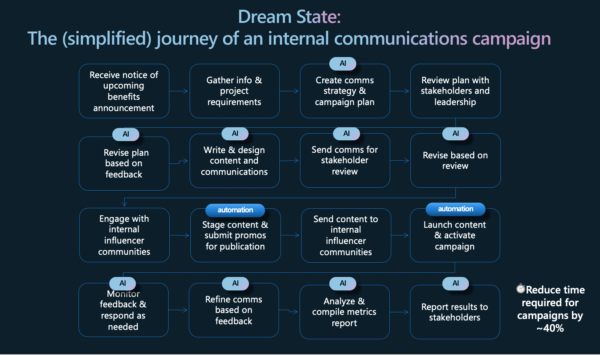Microsoft CCO Frank Shaw on how AI can enhance your internal communications workflow
Shaw shared his ‘Dream State’ internal comms workflow during Ragan’s Internal Communications Conference.

The rise of generative AI technology has proven to be a reckoning point for communicators over the past few years. Whether you fear that it could come for comms jobs in the future, or that it’ll free up communicator workflows for increased creativity and productivity, nearly everyone has an opinion on what AI means for the future of communication.
Microsoft Chief Communications Officer Frank Shaw kicked off Ragan’s Internal Communications Conference at Microsoft HQ in Redmond, Washington by demystifying the company’s AI innovations with Microsoft Copilot and explaining what tools comms pros can implement now for smoother sailing along their communications journeys.
Applying AI to key parts of the workflow
Shaw emphasized that workflows are central to every internal communications role. The opportunity lies in identifying the parts of those workflows where AI helps fill in the gaps.
Shaw outlined a simplified internal comms journey that always begins with a directive or news item that needs sharing. He said that AI can help work on the granular bits of those processes, allowing communicators to focus on the bigger picture.
These areas include:
- Creating a comms strategy and campaign plan.
- Revising the plan following feedback.
- Writing and designing content and communications.
- Revising based on review.
- Refining the comms based on audience feedback.
- Analyzing and compiling a metrics report

Frank Shaw’s workflow chart, as shared at Ragan’s 2024 Internal Communications Conference. [Image courtesy of Microsoft.]
“You’ve got to break processes down to their atomic steps,” Shaw told the crowd. “There are some things that will remain uniquely human, but other areas in which you can get an assist from AI. It can help us as communicators focus on the most important things.”
Shaw explained how AI can help pick up the day-to-day rote work that can bog down a communicator’s busy schedule, enabling them to focus on the projects that have tangible impacts on their employee audience. For one, AI can pick up many messaging responsibilities that currently fall on comms pros, including reviews and refinements.
“It’s a dream space that we’re driving toward,” he said. “We’re seeing a 20 to 30% improvement in total time to task that allows people more ability to do what they want to do.”
AI as a companion through the entire comms journey
True to its name, Shaw described Copilot as an assistant that’s able to navigate the waters of internal communications. He told the audience that just like any other part of a working person’s routine, to be effective, AI usage needs to become habitual.
“We’re all here because we’re good at our jobs — but if there was a way we could build net new tools and change our workflows through AI?” Shaw said. “For that to work, we need to make AI a habit and reconfigure how it fits in.”
Beyond the more well-known tasks it can handle like content creation and editing, Shaw suggested that communicators should implement AI as a source of feedback as well, sharing how Copilot can provide alternative ways to present a message or provide an alternative point of view for ideation. You could ask for feedback on a given thesis for a piece, or ask if there are alternative ways to engage an internal audience, another set of steps on his shared comms journey.
“Think about AI as a persona, as a sparring partner, as a brainstorming buddy,” Shaw said.
When used the right way, AI can also serve as a complementary tool that helps employees feel better about their job performance. Shaw said it’s helped teams streamline their sense of productivity and sense of satisfaction at work.
“People who like their jobs tend to perform well in their jobs and stay,” he said. “With this program, we really like what we’re seeing so far.”
Along for the entirety of the comms trip
The last steps of the internal communicators’ journey involve sharing the content at hand, monitoring it for feedback and analytics, and reporting the results back to your relevant stakeholders
Even with the help of an AI assistant or agent, a communicator’s influence is central to considering the needs of people and culture — particularly a culture of opportunity and trying new things.
“When you have that culture of opportunity and excitement, people will experiment,” Shaw said. “They will try new things, share how they failed and what they learned along the way. That’s the culture we want to build with all the new tools that come our way.”
With its reusable steps, Shaw’s map of automation’s influence along the comms journey applies to nearly any situation. Reminding communicators of the rapid decisions and judgments they will make in the upcoming election, Shaw ended with a hopeful note that leaning into the workflow while thinking about these specific AI inflection points can help comms pros breathe a little easier.
“When you’re in the hot seat, it’s good to have a set of tools that can help you a little bit,” he said.
Sean Devlin is an editor at Ragan Communications. In his spare time he enjoys Philly sports and hosting trivia.







